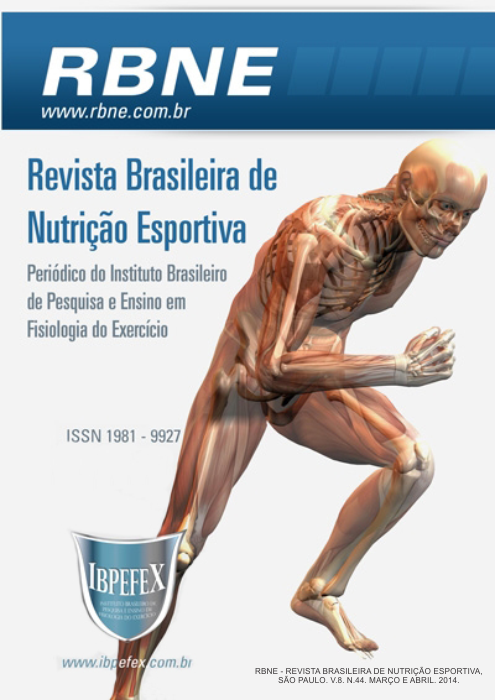Risk of acute myocardial infarction in bodybuilders of a gym in the city of Itatiaia-RJ
Abstract
This study aims to evaluate the risk of cardiovascular events in bodybuilders. Were diagnosed in the nutritional status of the study participants and applied the Framingham score to check the risk of myocardial infarction, angina or sudden death in the next 10 years. According to the nutritional diagnosis results were satisfactory, since 95% of the participants interviewed had normal weight, having low risk of developing cardiovascular disease. In relation to the score results were also satisfactory, as based on the results produced by this study, one can conclude that the majority of those treated have lower risk of developing cardiovascular diseasesover the next ten years. However Regarding the participants interviewed were observed some ofthe major risk factors, such as family history, physical inactivity and overweight, which in a small percentage, blood pressure levels presented consistent with hypertension. Porting was concluded that the use of the Framingham score should be encouraged in the context of primary care, as recommended by the guidelines of the SUS, since the possibility of estimating the absolute risk in ten years enables preventive actions, which is also still a need for greater awareness of society in general about life habits, in order to prevent the development of risk factors of cardiovascular diseases.
References
-Associação Brasileira para o Estudo da Obesidade e da Síndrome Metabólica. ABESO. Diretrizes Brasileiras de Obesidade. São Paulo. 2009. 85 p.
-Brasil. Ministério da Saúde. DATASUS-MS. Mortalidade proporcional por grupo de causas. Em <http://tabnet.datasus.gov.br/cgi/deftohtm.exe?id2004/c04def.>. Acesso em 30/09/2013.
-Brasil. Ministério da Saúde. Sistema de Vigilância Alimentar e Nutricional –SISVAN. Orientações para a coleta e análise de dados antropométricos em serviços de saúde. Brasília. 2008.
-Bressan, L.K.; Angeleli, I.F.; Nunes, F.J.; Rocha, V.S. Avaliação antropométrica e alimentar de uma academia da cidade de Saltinho/SP. 2012. Em < http://www.unimep.br/phpg/mostraacademica/anais/10mostra/4/141.pdf>. Acesso em 30/09/2013.
-Damilano, L.P.R. Avaliação do consumo alimentar de praticantes de musculação de uma academia de Santa Maria-RS. Em Revista Digital –Santa Maria-2006. Acesso em 15/06/2013.
-Dinardi, R.R.; Dinardi, L.R.; Soares, D.D. Análise de parâmetros de risco coronariano em adultos praticantes de atividade física em uma academia de ginástica localizada em um bairro de alto padrão socioeconômico na cidade de Belo Horizonte, MG. Revista Digital. Buenos Aires. Ano 14. Núm. 139. 2009.
-Guimarães, I.C.B.; Almeida, A.M.; Santos, A.S.; Barbosa, D.B.V.; Guimarães, A.C. Pressão arterial: efeito do índice de massa corporal e da circunferência abdominal em adolescentes. Arquivo Brasileiro de Cardiologia. Vol. 90. Núm. 6. p. 426-432. 2008.
-Lessa, P.; Furlan, C.C.; Capelari, J.B. Pedagogias do corpo e construção do gênero na prática de musculação em academias. Motrivivência. Ano XXIII. Núm. 37. 2011.
-Lollo, P.C.B. Perfil dos alunos das academias de ginástica de Campinas, SP. Revista Digital. Buenos Aires. Ano 10. Núm. 76. 2004.
-McArdle, D.W.; Katch, F.; Katch, V.L. Fisiologia do exercício: energia, nutrição e desempenho humano. 4ªedição. Rio de Janeiro. Guanabara Koogan. 1998.
-Rossato, C.E.; Mota, C.B.; Meereis, E.C.W.; Radin, L.D. Comparação de diferentes métodos para a identificação de sobrepeso. Revista Brasileira de Ciências da Saúde. Ano 10. Núm. 32. 2012.
-Santos, S.C.; Knijnik, J.D. Motivos de adesão à pratica de atividade física na vida adulta intermediária I. Revista Mackenzie de Educação Física e Esporte. Vol. 5. Núm. 1. p. 23-34. 2006.
-Santiago, L.M.; Sá, O.; Carvalho, I.M.; Rocha, M.G.; Palmero, L.; Mesquita, E.P.; Jorge, S. Hipercolesterolemia e fatores de risco cardiovascular associados, em crianças e adolescentes. Revista Portuguesa de Cardiologia. Vol. 21. Núm. 3. p. 301-313. 2002.
-Sarno, F.; Monteiro, C.A. Importância relativa do índice de massa corporal e da circunferência abdominal na predição da hipertensão arterial. Revista de Saúde Pública. Vol. 41. Núm. 5. p. 788-796. 2007.
-Sociedade Brasileira de Diabetes. SBD. Diretrizes da Sociedade Brasileira de Diabetes. São Paulo. 2008. 108 p.
-Souza, L.J.; Neto, C.G.; Chalita, F.E.B.; Reias, A.F.F.; Bastos, D.A.; Filho, J.T.D.D.; Souza, T.F. Prevalência de obesidade e fatores de risco cardiovascular em Campos, Rio de Janeiro. Arquivo Brasileiro de Endocrinologia Metabólica. Vol. 47. Núm. 6. 2003.
-Souza, J.C.C.; Oliveira, D.G.; Espírito Santo, G. Percepções e motivações acerca da prática de musculação de uma academia de ginástica da baixada fluminense. Corpus et Sciencia. Vol. 8. Núm. 2. p. 66-77. 2012.
-Tahara, A.K.; Schawartz, G. M.; Silva, K.A. Aderência e manutenção da prática de exercícios em academias. Revista Brasileira de Ciência e Movimento. Vol.11. Núm. 4. p. 7-12. 2003.
-Teixeira, A.M.N.C.; Sachs, A.; Santos, G.M.S.; Asakura, L.; Coelho, L.C.; Silva, C.V.D. Risco Cardiovascular em Ambulatório de Nutrição. Revista Brasileira de Cardiologia. Vol. 23. Núm. 2. p. 116-123. 2010.
Authors who publish in this journal agree to the following terms:
- Authors retain the copyright and grant the journal the right of first publication, with work simultaneously licensed under the Creative Commons Attribution License BY-NC which allows the sharing of the work with acknowledgment of the authorship of the work and initial publication in this journal.
- Authors are authorized to enter into additional contracts separately for non-exclusive distribution of the version of the work published in this journal (eg, publishing in institutional repository or book chapter), with acknowledgment of authorship and initial publication in this journal.
- Authors are allowed and encouraged to post and distribute their work online (eg, in institutional repositories or on their personal page) at any point before or during the editorial process, as this can bring about productive change as well as increase impact and impact. citation of published work (See The Effect of Free Access).






